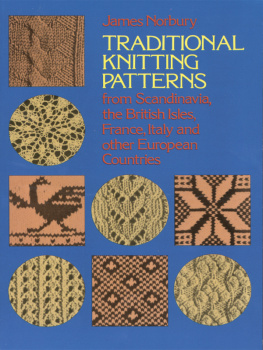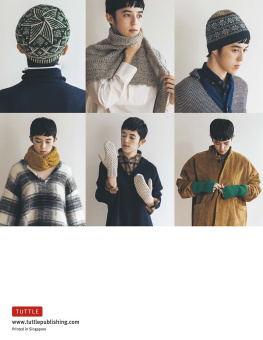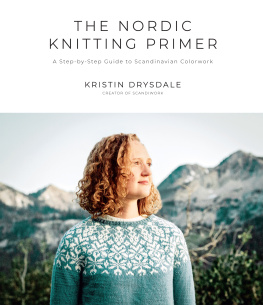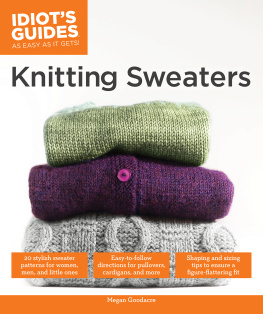
Dolce Handknits
SIMPLE, SOPHISTICATED DESIGNS
Kim Dolce

Dolce Handknits: Simple, Sophisticated Designs
2010 by Kim Dolce

Martingale & Company
19021 120th Ave. NE, Suite 102
Bothell, WA 98011 USA
ShopMartingale.com
eBook Edition: 2013
No part of this product may be reproduced in any form, unless otherwise stated, in which case reproduction is limited to the use of the purchaser. The written instructions, photographs, designs, projects, and patterns are intended for the personal, noncommercial use of the retail purchaser and are under federal copyright laws; they are not to be reproduced by any electronic, mechanical, or other means, including informational storage or retrieval systems, for commercial use. Permission is granted to photocopy patterns for the personal use of the retail purchaser. Attention teachers: Martingale encourages you to use this book for teaching, subject to the restrictions stated above.
The information in this book is presented in good faith, but no warranty is given nor results guaranteed. Since Martingale has no control over choice of materials or procedures, the company assumes no responsibility for the use of this information.
Library of Congress Cataloging-in-Publication Data is available upon request.
eISBN: 978-1-60468-126-0
Original Source ISBN: 978-1-60468-013-3
DEDICATION
For James; you inspire me.
ACKNOWLEDGMENTS
My warmest regards and appreciation to the lovely people I have had the pleasure of working with at Martingale & Company, especially during my all-too-brief visit to Woodinville, Washington. Special thanks to Karen Soltys for your calming manner, to Shelly Garrison for listening so thoughtfully to my ideas, and to Brent Kane for your keen eye behind the camera.
Id also like to thank Jodi Lewanda, Judy Seip, and Donna Warnellwonderful knitters all. Without your nimble fingers, I would still be knitting these sweaters. And special thanks to the yarn companies who generously support Dolce Handknits with such beautiful yarns. It was truly a pleasure to work with each and every one of you.
Contents
Introduction

I was always drawn to the creative process, but never considered myself to be truly creative. That was an elusive thing reserved for those who use color with wild abandon or see wondrous creations in what I see only as someone elses cast-offs. I was always too critical of my own end result to color outside the lines. While I still marvel at the imagination and free spirit of others, Ive come to understand that I, too, am creative. Knitting allows me to express both my practical and creative sides so that coloring within the lines is more than acceptable. Knitting can be as simple or as complex as I choose to make it. I can create something useful and make it something lovely. And most of all, Ive chosen knitting as my craft because its forgiving. With one tug of a string I get to erase my mistakes, learn from them, and try again.
In this, my first book, youll find designs for every season and many occasions. Most often, I design and knit what I want to wear. As knitters, we put so much time and effort into what we create, I believe it should be something we love and will ultimately wear. I hope youll find something to love and wear in the designs Ive imagined for my own closet.
Yarn Considerations
Knitting, like most things in life, is full of joy and frustration. One of my greatest joys in knitting is finding the perfect yarn for a project. Before I began designing, I remember the frustration of not being able to find the yarn called for in a pattern and my fear of making an uninformed choice when substituting yarn.
In an ideal world, youd love my yarn selections and be able to find them locally. However, most yarns arent available indefinitelyor you may simply want to use something different. Yarn substitution is not an exact science, and some of your choices may be better than othersIve found that to be truebut with a little homework, you can increase your chances for success when substituting yarns.
Search out the original yarn, even if you have no intention of using it. The more you know about itits composition, weight, drape, twist, and handthe more youll know what else will work successfully. For each yarn used in this book, Ive provided the basic information given on the yarn label as a guide. Local yarn-shop owners and employees have a wealth of knowledge, so shop locally to take advantage of that experience. When its not possible to visit a yarn shop, try the yarn companys website, Ravelry, or sites like Knitters Review and Yarndex to research yarn.
While an accurate gauge is essential to achieve the correct size, its not the be-all and end-all of yarn substitution. Not every yarn with a suggested gauge matching your project will be an appropriate substitute. Remember, a suggested gauge is just that, a suggestion. Most yarns work up beautifully across a small range of needle sizes and gauges. If you fall in love with a yarn, invest in one skein and swatch it on several different needle sizes. Just dont fall in love so deeply that you force a yarn to do what it really doesnt want to do; there will always be another project perfect for that yarn. Be mindful that the fabric you create is not too dense or too loose at the desired gauge. And always swatch a yarn to determine the gauge and suitability of a substitute yarn.
Fiber content is also an important factor in yarn selection. Using a yarn with the same fiber content as the specified yarn will most likely make for a more successful substitution, but it isnt always essential. Knowing something about the properties of a particular fiber will help guide you in selecting a yarn. Elasticity, drape, and weight are all important and should be considered relative to the ultimate use of the garment you plan to knit. If youre unfamiliar with the properties of fibers, there are wonderful books available to guide you. See the list of references in the bibliography on .
Size Considerations
Once you know what you want to knit and have found the perfect yarn, youll need to decide on a size. For each project in this book, youll find two sets of measurementsthe finished measurements listed at the beginning of each pattern and those in the schematics. Finished measurements give the bust and length of the sweater after its blocked, seamed, and finished, while the schematic typically gives the measurements of each knitted piece before blocking.
I dont include size designations such as Small, Medium, and Large because with no point of reference, they arent of much help. As a knitter, you should know your measurements and how you like your clothes to fit, or in other words, the amount of ease you prefer. I give a suggested ease for each sweater, though its only a suggestion. To determine which size to knit, add the desired ease to your bust measurement, and then select the closest size listed in the finished measurements.
In addition to your bust size, its helpful to know what length looks best on you. Designs can be adjusted for length, although those without waist shaping are much simpler to alter.
Next page









